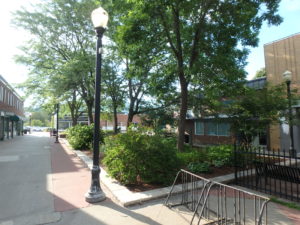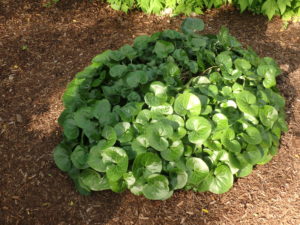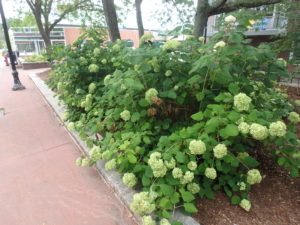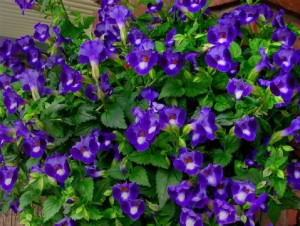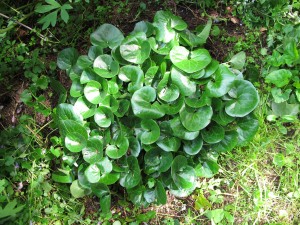Growing Flowers in Shade with Root Competition
Folks who only have shade often give up on gardening because they cannot grow things like poppies and peonies, and only know “boring” shade plants planted for their foliage rather than their blossoms: hostas, pachysandra and myrtle. But even those plants don’t necessarily grow vigorously in shade. More often the not, the problem is not shade, but root competition.
Ten years ago my partner, Cindy Heath and I accepted the task of designing and installing a garden for the city of Lebanon, NH on the mall near two nice restaurants. The space is 30 feet wide and 60 feet long. When I took on the job it had 3 locust trees and 2 green ash trees which kept most of the potential garden in shade. The soil was covered with 3-4 inches of bark mulch, many weeds, and half a dozen hostas. We got the city to remove one tree, so there are sunny places now.
When I dug into the bark mulch I found roots from the trees everywhere; when I dug into the soil I found gravel, sand, bricks and rubble. Not a place conducive to gardening – even the weeds were struggling and undersized. Anything planted in the space would be competing with the trees for both minerals and water.
So here is what we did: we had good soil and compost brought in and spread out everywhere – 3 or 4 inches deep. We covered the mulched wood chips with soil to break down over time, adding much needed organic matter.
Next we built berms: mounds of soil and compost 8-12 inches deep arranged in large beds with curved lines. The tree roots eventually migrated into these “root free zones”, but by then the plants there had established themselves and were better able to compete with the tree roots.
At planting time we added plenty of slow release fertilizer and mineral supplements. I used a slow-release organic fertilizer, along with green sand and rock phosphate.
Green sand is a natural soil supplement that increases potassium levels and adds many micronutrients from the sea, where it formed millennia ago. It promotes strong cell walls, which helps plants withstand drought, heat and cold.
The rock phosphate, which is a finely ground rock containing significant quantities of slow-breakdown phosphorus-containing minerals, will not wash away and breaks down over a multi-year period. It promotes good root growth and flowering.
We top-dressed the plants most years with extra fertilizer and minerals, knowing that they are competing with the tree roots. A local volunteer waters during dry times, which helps a lot.
What did we plant? We had been given hostas and daylilies by local citizens, along with a few irises. I timed the sun traveling across the sky and saw there were places that got 6 hours of sun – enough for the daylilies, iris and few annuals. New Guinea impatiens and impatiens have done well most years, and in the sunnier spots zinnias, marigolds and cleome are welcome color.
What plants have thrived, now 10 years later? Hostas did great. European wild ginger (Asarum europaeum), with its glossy green leaves has thrived, forming big clumps. We planted a small patch of snakeroot (formerly Cimicifuga racemosa, now Actea racemosa) that has done fabulously, with flower stalks standing 5 feet tall with white, bottle-brush, fragrant flowers. It has spread to fill in its bed nicely.
Bigroot geranium (Geranium macrorrhizum) has done fine, with spring flowers and nice leaves all summer long. I also planted fringed bleeding heart (Dicentra exemia), which also did fine.
What disappeared or failed to thrive? A ground cover known as spotted dead nettle (Lamium maculatum). Normally dead nettle thrives in shade, but the root competition was too great, and it is virtually gone. Also almost gone now is lungwort (Pulmonaria officinalis), another shade stalwart. Coral bells (Heuchera spp.), which does well in shade elsewhere, did not survive. Daylilies, even those tough common orange ones, have survived – but have not thrived.
We also planted a few tough shrubs, and all have done well: a Miss Kim lilac, 2 shad bushes (Amelanchier spp.) and a pair of hydrangeas (Hydrangea arborescens), a variety called ‘Hills of Snow’. This has smaller blossoms than the popular ‘Annabelle’, but does well in shade and the small flowers do not flop so much on rainy days. When planting the shrubs I dug extra wide holes to keep the existing tree roots at bay a little longer. We cut back any tree roots we found at planting time.
So don’t despair if you lack a nice sunny spot for flowers. Even in dry shade you can have flowers – but you may have to try several to find just the right ones for your situation.
I am hoping to help lead a Viking River Cruise next June from Paris to Normandy and back with stops along the way – including Monet’s magical garden, Giverny. If there is enough interest, we might have 3 days in Paris looking at gardens there. If you are interested, e-mail me at henry.homeyer@comcast.net.
Shade Annuals
Last fall a reader alerted me to the fungal disease that has devastated that wonderful shade annual, impatiens, throughout much of New England. The disease, called impatiens downy mildew, will be a problem again for most gardeners this year. Any garden that had the disease last year will have it again this year – even our coldest winters will not cleanse the soil of it. I wish I had known about it sooner, as prompt removal of affected plants may stop the spread of the disease. So if you did not have the disease last year, watch your plants carefully this year and bag and dispose of any diseased plants promptly.
Impatiens downy mildew symptoms are these: yellowing of leaves, then a limp appearance, as if it needs to be watered. Next comes a downy white fungal growth on the undersides of leaves. Then leaves and flowers drop, leaving just a stem with a few leaves on top – as if slugs had eaten the leaves. I have read that if you don’t plant impatiens in a site that has had the disease for a year or two, the soil may become free of disease. But I wouldn’t count on it.
There are two related plants that will thrive in shade or part shade and that are not susceptible to the mildew: New Guinea impatiens and SunPatiens, which is a trademarked hybrid. SunPatiens is advertised as good for part sun to sun – but not deep shade. But it is being marketed as a replacement of impatiens. I wonder if it will be able to bloom as vigorously as our old favorite in full shade. Both are generally sold in individual pots for around $5, quite an upgrade from a six-pack for $3.50 or so that I was accustomed to paying for impatiens in past years.
Another plant that is being touted as a replacement for impatiens is Torenia. I spoke to two landscapers who have used Torenia in past years and say that it is nice enough, but it will not satisfy impatiens-lovers. I’ve heard that it does not have as many blossoms per plant, generally, and is often available in just a few colors – shades of blue and purple, and in white. However, I have found it for sale in multi-packs in a few places and did find one nursery with 4-packs that listed rose, magenta, lemon drops and white as colors available.
I have used bedding lobelia as a nice shade annual, though in my experience it wants a little sun or filtered sun. I love the intense blue that it often displays, though it is available in other colors, too. I started seeds indoors back on April 17, a mix called ‘Cascade of Color’ that promised blue, blue with a white eye, lilac, red, ruby and white.
Right now my lobelia seedlings are only 2 inches tall but I assume they will take right off when I separate them and get them in the ground. The only problem with a mix like that is that one cannot determine what color any given seedling will be – unless you wait for them to bloom in the pot. And, when I read the seed packet (from Botanical Interests) just now, I see that this variety is advertised for full sun. I have plenty, so I’ll try some in shade, too.
So what else can we do to provide color in shade? Try some perennials. Granted, most only bloom for 1 to 3 weeks, but if you select plants with good foliage they can be a joy all summer. I love European wild ginger (Asarum europaeum) for its very glossy dark green leaves. It forms a nice expanding clump, even in dry shade with competition from tree roots. The blossoms are hidden beneath the foliage, but it doesn’t matter to me. This is a great shade plant. I plant them in clumps of three about 18 inches from center to center.
Then there is bigroot geranium (Geranium macrorhizum). Not to be confused with your mom’s red geraniums (which are technically not geraniums at all), this is a nice spreading plant that thrives in full shade and blooms with pink, magenta or white flowers in late May or early June. The leaves look good all summer, each plant a spreading mound 12 to 18 inches tall and 15 inches wide. I use it as a groundcover. I have read that it will do well in sun, too, and that it tolerates a wide range of soil and pH conditions. If it wanders too far? It pulls easily, and you can give the roots to someone who doesn’t have it.
I have never tried either the geranium or the ginger in a pot, but will this year and grow them on my north-facing, shady deck. I’ll give them a 50-50 mix of standard potting soil and compost, and I bet they look just fine.
It seems that every year there is a new bug or a new disease that threatens some plant in our garden. I guess we will have to keep on adapting and changing – just like the pests do. Good luck!
Henry Homeyer is the author of 4 gardening books and a children’s fantasy-adventure called Wobar and the Quest for the Magic Calumet. You may reach him at PO Box 364, Cornish Flat, NH 03746 or henry.homeyer@comcast.net.\



